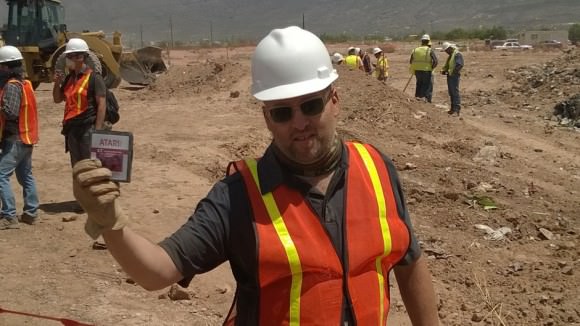Documentary filmmakers digging in a New Mexico landfill on Saturday unearthed hundreds of “E.T. the Extra-Terrestrial” cartridges, considered by some the worst video game ever made and blamed for contributing to the downfall of the video game industry in the 1980s.
Some gamers speculate that thousands or even millions of the unwanted cartridges made by Atari were buried in a landfill in Alamogordo, about 200 miles southeast of Albuquerque.
“We found something,” film director Zak Penn told an excited crowd at the dig site this afternoon. “We found an intact ET video game. The actual cartridge is still in there.”
That’s from video of the discovery that was posted to the IGN website. Those taking part in today’s search for say there are many more copies of the E.T. game in the area being excavated.
The search for the trove of discarded cartridges has taken on a sort of mythical importance for some gaming fans, who see the mystery of what became of millions of consoles as an explained event in digital culture. It’s part of a broader field some call “archaeogaming” that, as you might guess, combines elements of archaeology with the study of video games.
And then there’s the simple nostalgia for E.T., the film, and for the 1980s in general. A comment by reader Kascha Klaussen on our 2013 post about the effort to find E.T. games summed up those sentiments nicely:
“I wish that the second they pulled the first shovel full of dirt out of the ground over this pit, the entire Earth would be pulled inside out centered entirely on this spot and when it came right side up again? It would be 1982 again and I could be in the arcade with my girlfriends trying to impress boys and waiting to go see Tron with them while Love Plus One plays over the loudspeakers. Oh and we could be fighting over the last Apple stick as well. That wouldn’t hurt a bit.
“Yes, 13 Going On 30 is in fact, a permanent resident of the DVD rack. Why of course yes. I DO watch it in reverse.”
As we reported back then, some experts have said that unreleased Atari products, such as a prototype for its “Mindlink” device, might also be in the desert landfill.
Agencies/Canadajournal
 Canada Journal – News of the World Articles and videos to bring you the biggest Canadian news stories from across the country every day
Canada Journal – News of the World Articles and videos to bring you the biggest Canadian news stories from across the country every day



